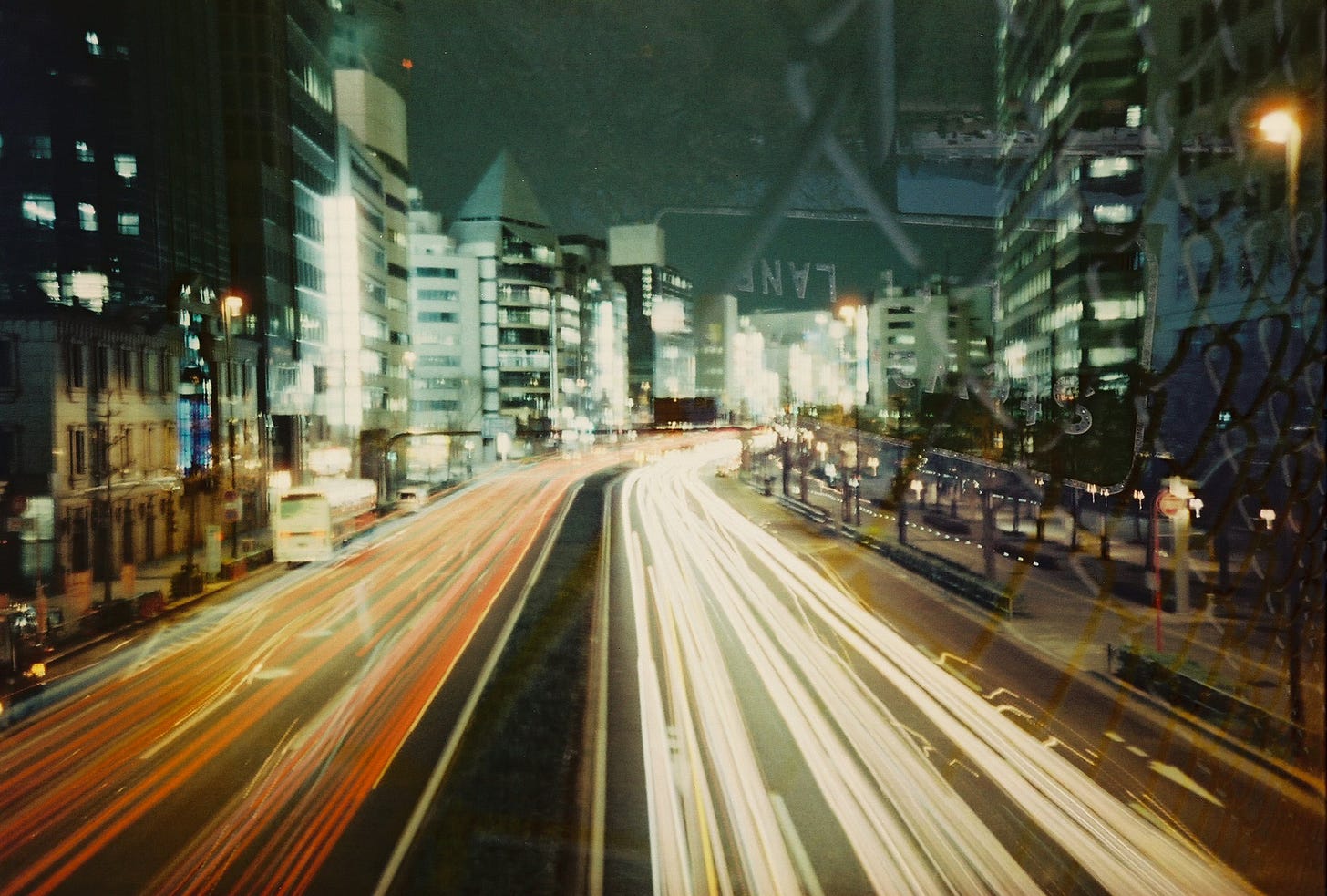Thanks for reading For the Birds! I publish this newsletter for free twice a month as both a writer and a creativity coach. My goal is to enact and reflect on creativity; these letters are born from my own artistic vision, but they carry the hope of encouraging you in yours.
The best way to support this work is by becoming a paid subscriber! You’ll receive four monthly posts while contributing directly to the evolution of this space. Paying writers & artists for their work is hella good karma, too.
1.
For two years now I have carried around a letter from V, one of my best and oldest friends, inside my bright blue laptop bag. A response to a postcard I’d sent her in July of 2021, it’s a four-page letter on Totoro stationary printed, I realize in this moment, not in Japanese and English but in Japanese and Italian—il mio vicino Totoro—and written in the precise penmanship I’ve come to expect from her.
V is an artist. She also happens to be an engineer.
She writes:
For me, multitasking is the death of a boundary, and I didn’t realize this until I lived it, until my body said no more, until my mind said no more.
You don’t need the full context to glean the wisdom of what she’s saying. Boundaries aren’t only about our relationships with other people. They are also, first and foremost, about our relationship with presence, and therefore with ourselves; with where and how our use of time flows and trips and diverges. Multitasking, V is saying, diverts the self from the moment. Rips the self away from the self.
2.
But other people, too, play a role in our boundaries, and our boundaries play a huge role in how we get to experience other people. And boundarylessness, I have often learned the hard way, isn’t always a result of aggression. Often, there’s a thick layer of insecurity just beneath the surface.
2.2
Maybe I should mention: At the time of writing this, I’m on day 172 of a Duolingo streak. I am trying to learn Italian. I am trying—and this is one of the few times you’ll hear me use this word in earnest—to manifest a trip to Italy. I’m bursting at the seams with desire to connect with my ancestors, to cultivate a sense of a family tree that’s more than a pencilled sketch. And because of the strange boundaries between this plane of existence and the next one, and the majority of relatives who now reside in the latter, the only real step forward I can take is to go there; to believe the feeling inside me that’s saying I can get what I need from the atmosphere and the environment and the gravestones.
Without a sturdier sense of roots, my insecurities tend to bubble up with ease, desperate for air. Looking for familiar names and noses, hands that move like mine, animatedly. Looking for a unique softness between me and certain others.
3.
Having good boundaries means you’ll feel people pushing up against them: pushing, bumping, bouncing, running, pressing, forcing, trying—in other words, making contact. People are going to make contact with your boundaries, which is the reason we need them.
Which is also to say, it’s a mistake to assume that the point of our boundaries is to avoid the discomfort of other people running into them. Which is even more so to say: Discomfort is not a sign of poor boundaries, nor of their failure. Discomfort, in fact, is a pretty big part of having and holding your own safe perimeters in the first place.
We don’t create boundaries to avoid discomfort; we create boundaries to avoid harm.
4.
In the realm of creativity and, in particular, on the page: How do we distinguish between boundaries (structure) and boundaries (limitation)? How do I tell when I’m looking at scaffolding, a strong thing holding me up and bringing me closer to my goals, versus a locked and gated entry, something rerouting me in an unchosen direction?
The answer, always always always, lives in the body. Do you feel held, or pressed? Do you feel energized, or depleted? Remember that discomfort can accompany even the good feelings, the discomfort of infinite nature bumping up against the finite edges of our and each other’s humanity.
This is why we need to listen to the body’s no mores. This is why my friend’s language is necessarily strong, why we need to talk about this subject in grave terms. The death of…
5.
Of my choices. Of my say. Of my opinion. Of my personhood. Of my interest. Of my enthusiasm. Of my health. Of my equilibrium. Of my mental and/or emotional wellbeing. Of my joy. Of my pleasure. Of my fun. Of my sovereignty. Of my purpose.
In the numerous circumstances in which I’ve found myself over the years relinquishing my borders or being complicit in their trampling: An absence of good boundaries always led to the death of my real self, made me a ghost in my own life.
The terms are grave ones.
6.
A good question to ask oneself, as an artist / writer / parent / citizen / self-advocate: What am I trying to keep alive?
Again from V’s letter:
But having lived through this, I know what I want: To be there for her.
So there are the roots we tend—our origin stories. And then there’s the sturdy-soft ground of the self. And then, for some of us, there are also the sprouts.
Ancestry making itself known in multiple directions.
7.
Why are boundaries so fucking difficult? I feel called to answer bluntly: Because we become them. Because we turn into the fence, the emotional perimeter, the surface bordering our interiority, which is why we feel it so immediately and sharply when somebody crosses over it, us. We are both: the caught thing, the catching thing. We are the boundaries we hold. We hold them while catching their consequences in the chainlink fence of our outline. Sometimes we shift. Sometimes the world, others, move toward us at alarming speeds.
8.
The world continues to change around you and charge toward you whether you have good boundaries or not, but the point is that good boundaries do not stop the world from changing, do not prevent the difficult thing from getting closer. They do not stop other difficult things from existing in the first place. Boundaries exist alongside the things that warrant them. In this way, they’re more creation than destruction.
“Abundance is scooped from abundance yet abundance remains.”
Boundaries support abundance.
9.
Again from V’s letter:
It seems I have to live through it before realizing I crossed a boundary, and other times I’m fortunate enough to make time or receive time to think about the boundary.
Making. Receiving. Living through.
The terms are grave, but they’re also buoyant.
10.
Other people may not understand your boundaries, or may not take the time to notice them, or may not be equipped in the first place to recognize a boundary not of their own making. Boundaries won’t prevent contact with those who would attempt to break them. Instead, they prevent the wrong kind of contact, the kind that smushes you, the kind that makes you feel as if you’ve gone away. The kind where you fall perpetually backwards because it feels like the only way to keep the other person from climbing aboard you and doing all the boundaryless things that people do while standing on top of or inside of your bubble.
Some people will think poorly of you no matter how good you are, and their poor thoughts don’t mean anything about your goodness. Remembering this is another kind of boundary, too.
Oh gawd, how many times have one of my boundary’s gone immediately extinct in response to the fear of someone thinking poorly of me?
11.
Boundaries support abundance. I just felt like saying it again.
Speaking of feelings: You are alive! And despite anything that suggests otherwise: you are good. This combination naturally invites one to dream of perpetual openness. Boundaries might impede perpetuity, but they also protect the dreaming.
It is always a little uncomfortable when one living thing encounters another, even if they are both good, because life means possibility, and possibility includes all of it—good, bad, & otherwise. Then you add feelings to the mix, which do and don’t sync up with reality to varying degrees…
You don’t need to understand the discomfort, and you don’t need to justify your boundaries, and you don’t need to circle every single desirable feeling with a bold red marker and try to make the other ones go away. You can brace yourself, choose to exist firmly, close your doors and windows when you want to, and let the feelings come and go.
Yes, you can accept your feelings—like a good feminist, you can tend to all of them—and have boundaries with their consequences, too.
Ways you & I can work together:
Through the end of November, I’m offering themed Creativity Readings. The metaphorical possibilities of this time of year are so so rich; let’s invite monsters, thin veils, and all of your (and my!) favorite spooky things into an exploratory conversation about this moment of your creative journey.
You’ll walk away from the experience with new insights, big questions, and an increased sense of your creative agency. Shortly thereafter, you’ll receive a personalized written reading and audio recording from me, which will go into further depth around what we discovered together, while providing you with a creative compass you can return to again and again.
Learn more here, or reach out directly with yr questions!
For the entrepreneurs & spiritually inclined small business owners in the room: I’m now also offering Creativity Readings for you and your biz!
What paid readers of FtB will receive in the coming months:
Thin-veiled nourishment. An extra boost of poetic magic (just in time for Samhain). The next three entries in my “Struggling toward an Artist's Statement” series. Some thoughts about integration, consistency, and writing routines. And more nature-inspired oracles.
A reflective prompt for you:
Think about what an ideal day looks and feels like to you. Then, setting aside however well you do or don’t maintain them, think about two boundaries that likely contribute to that ideal day. If you had a magic wand that could resolve one of them, so that you never, ever had to worry about maintaining it and could always rely on its sturdiness, which one would it be? Spend some time journaling, with curiosity, around why that is.
Tell me what the prompt brings up…
Or what inspired / challenged you while reading today’s letter. Your input is a gift!
If you’re on the site or in the Substack app, hit the “comment” button to share publicly.
If you’re reading this via email, hit “reply” to keep the conversation one-on-one.












Thank you for writing! There may be at least three kinds of boundaries: a total wall, a former boundary that is removed, like a fence that once separated neighbors, and one becoming popular in lands where beavers have built a dam. A beaver dam backs up water and that is ecologically vital, but not so good for humans if the waters impact structures. Biologists can construct a "beaver deceiver" which keeps most of the dam, yet allows some free-flowing waters resulting in a partial barrier.
While it is good to establish barriers between people as they start work-based, friendships, or neighborly relationships, the challenge comes when a full barrier yearns to become a partial boundary or becomes one. The protagonist in the book Lessons in Chemistry tells her partner that she never wants to marry nor have children. and her friend agrees, but then (spoiler alert) he dies she is pregnant.
"I'm never going to talk to you again!!!" creates a fairly stark boundary, a line that may have been stated in a fit of rage or misunderstanding. Healing can poke holes into a wall.
Nature abhors walls, fences, barriers of any kind. When our neighbors appeared one morning and started removing their boundary fence, we immediately grew closer, and the deer were no longer prevented from accessing both properties.
Language can be a mammoth barrier between peoples. Hooray! you are learning Italian. And while your wonderful friendship with your Italian buddy goes beyond language, you learning Italian is a sign of love and respect, and will allow you deeper access to Italian culture and will expand the boundaries of your friendship. ~